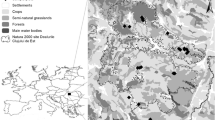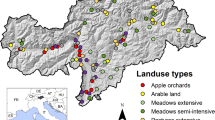Abstract
A widespread decline in biodiversity in agro-ecosystems has been reported for several groups of organisms in Western Europe. The butterfly fauna was studied in 60 selected semi-natural grasslands in a coniferous-dominated boreal landscape in south-eastern Sweden. The aim was to investigate how butterfly assemblages were affected by the amount of semi-natural grasslands in the surrounding landscape. Furthermore, we wanted to determine if semi-natural grasslands in boreal landscapes harboured species otherwise declining in other parts of Europe. For each study site, the amounts of semi-natural grasslands in the landscape within radii of 500, 2,000 and 5,000 m were studied. Nine local habitat factors were also recorded. Only the amount of semi-natural grasslands within a 5,000 m radius could explain a significant part of the variation in butterfly composition, but there was no clear relationship between the amount of semi-natural grassland and butterfly diversity. Instead, this study showed that local habitat quality was very important for butterfly diversity at individual sites. Flower abundance, sward height and herb composition were the most important local factors. Patches surrounded by a small amount of semi-natural grasslands had high butterfly diversity, contrary to expectations. This may be explained by the fact that forest habitat provides a matrix with several features suitable for butterflies. The butterfly fauna was rich in species representative of low-productivity grasslands, species that are declining in other countries in Western Europe.



Similar content being viewed by others
References
Asher J, Warren M, Fox R, Harding P, Jeffcoate G, Jeffcoate S (2001) The millennium atlas of butterflies in Britain and Ireland. Oxford University Press, Oxford
Bergman K-O, Askling J, Ekberg O, Ignell H, Wahlman H, Milberg P (2004) Landscape effects on butterfly assemblages in an agricultural region. Ecography 27:619–628
Bergman K-O, Landin J (2001) Distribution of occupied and vacant sites and migration of Lopinga achine (Nymphalidae: Satyrinae) in a fragmented landscape. Biol Conserv 102:183–190
Binzenhöfer B, Schröder B, Strauss B, Biedermann R, Settele J (2005) Habitat models and habitat connectivity analysis for butterflies and burnet moths-The example of Zygaena carniolica and Coenonympha arcania. Biol Conserv 126:247–259
Dennis RLH (2004) Butterfly habitats, broad-scale biotope affiliations, and structural exploitation of vegetation at finer scales: the matrix revisited. Ecol Entomol 29:744–752
Dennis RLH, Eales HT (1997) Patch occupancy in Coenonympha tullia (Müller, 1764) (Lepidoptera: Satyrinae): habitat quality matters as much as patch size and isolation. J Insect Conserv 1:167–176
Diekmann M (1999) Southern deciduous forest. In: Rydin H, Snoeijs, P, Diekmann M (eds) Swedish plant geography, Acta phytogeographica Suecica, pp 33–53
Ekstam U, Forshed N (1996) Äldre fodermarker. Naturvårdsverket, Solna
Ekstam U, Forshed N (2000) Svenska naturbetesmarker. Naturvårdsverket, Solna
Eliasson CU, Ryrholm N, Holmer M, Jilg K Gärdenfors U (2005) Nationalnyckeln till Sveriges fauna och flora. Fjärilar: Dagfjärilar. Hesperiidae-Nymphalidae. Artdatabanken, SLU, Uppsala
Erhardt A, Thomas JA (1991) Lepidoptera as indicators of change in the semi-natural grasslands of lowland and upland Europe. In: Collins NM, Thomas JA (eds) The conservation of insect and their habitats. Academic Press, London, UK
Fahrig L (2001) How much habitat is enough? Biol Conserv 100:65–74
Fox R, Warren MS, Harding PT, McLean IFG, Asher J, Roy D, Brereton T (2001) The state of Britain butterflies. Butterfly Conservatio, CEH and JNCC, Wareham
Franzén M, Ranius T (2004) Occurrence patterns of butterflies (Rhopalocera) in semi-natural pastures in Sweden. J Nat Conserv 12:121–135
Hanski I, Moilanen A, Gyllenberg M (1996) Minimum viable metapopulation size. Am Nat 147:527–541
Kearns CA, Inouye DW, Waser NM (1998) Endangered mutualism: the conservation of plant–pollinator interactions. Annu Rev Ecol Syst 29:83–112
Kivinen S, Luoto M, Kuussaari M, Helenius J (2006) Multi-species richness of boreal agricultural landscapes: effects of climate, biotope, soil and geographical location. J Biogeogr 33:862–875
Krauss J, Steffan-Dewenter I, Tscharntke T (2003a) How does landscape context contribute to effects of habitat fragmentation on diversity and population density of butterflies? J Biogeogr 30:889–900
Krauss J, Steffan-Dewenter I, Tscharntke T (2003b) Local species immigration, extinction, and turnover of butterflies in relation to habitat area and isolation. Oecologia 137:591–602
Krebs JR, Wilson JD, Bradbury RB, Siriwardena GM (1999) The second silent spring? Nature 400:611–612
Leps J, Smilauer P (2003) Multivariate analysis of ecological data using CANOCO. Cambridge University Press, Cambridge
Lindborg R, Eriksson O (2004) Historical landscape connectivity affects present plant species diversity. Ecology 85:1840–1845
Maes D, Van Dyck H (2001) Butterfly diversity loss in Flanders (north Belgium): Europe’s worst case scenario? Biol Conserv 99:263–276
Mungiura ML, Thomas JA (1992) Use of road verges by butterfly and burnet populations, and the effect of roads on adult dispersal and mortality. J Appl Ecol 29:316–329
Öckinger E, Hammarstedt O, Nilsson SG, Smith HG (2006) The relationship between local extinctions of grassland butterflies and increased soil nitrogen levels. Biol Conserv 128:564–573
Pullin AS (ed) (1995) Ecology and conservation of butterflies. Chapman & Hall, London
Robinson RA, Sutherland WJ (2002) Post-war changes in arable farming and biodiversity in Great Britain. J Appl Ecol 39:157–176
Sawchik J, Dufrêne M, Lebrun P (2003) Estimation of habitat quality based on plant community, and effects of isolation in a network of butterfly habitat patches. Acta Oecol 24:25–33
Schneider C, Fry GLA (2001) The influence of landscape grain size on butterfly diversity in grasslands. J Insect Conserv 5:163–171
Steffan-Dewenter I, Tscharntke T (1997) Early succession of butterfly and plant communities on set-aside fields. Oecologia 109:294–302
Steffan-Dewenter I, Tscharntke T (2000) Butterfly community structure in fragmented habitats. Ecol Lett 3:449–456
Swedish Board of Agriculture (2005) Swedish agriculture in figures 1800–2004. Statistikrapport :6
Swedish Environmental Protection Agency (2006) Handbok för miljöövervakning. Dagaktiva fjärilar. www.naturvardsverket.se/dokument/mo/hbmo/del3/landskap/dagfj.pdf, Cited 1 February 2007
ter Braak CJF, Smilauer P (2002) Canoco reference manual and user’s guide to Canoco for windows: software for Canonical Community Ordination (version 4). Microcomputer Power, Ithaca, NY
Thomas CD, Hanski I (1997) Butterfly metapopulations. In: Hanski I, Gilpin ME (eds) Metapopulation biology: ecology, genetics and evolution. Academic Press, pp 359–386
Thomas CD, Thomas JA, Warren MS (1992) Distribution of occupied and vacant butterfly habitats in fragmented landscapes. Oecologia 92:563–567
Thomas JA, Bourn NAD, Clarke RT, Stewart KE, Simox DJ, Pearman GS, Curtis R, Goodger B (2001) The quality and isolation of habitat both determine where butterflies persist in fragmented landscapes. Proc R Soc Lond B 268:1791–1796
Thomas JA, Telfer MG, Roy DB, Preston CD, Greenwood JJD, Asher J, Fox R, Clarke RT, Lawton JH (2004) Comparative losses of British butterflies, birds, and plants and the global extinction crisis. Science 303:1879–1881
Van Swaay CAM, Warren MS (1999) Red Data book of European butterflies (Rhopalocera). Council of Europe Publishing, Strasbourg
Vellend M, Verheyen K, Jacquemyn H, Kolb A, van Calster H, Peterken G, Hermy M (2006) Extinction debt of forest plants persist for more than a century following habitat fragmentation. Ecology 87:542–548
Vessby K, Söderström B, Glimskär A, Svensson B (2002) Species-richness correlations of six different taxa in Swedish seminatural grasslands. Conserv Biol 16:430–439
Warren MS (1993) A review of butterfly conservation in central southern Britain: I. Protection, evaluation and extinction on prime sites. Biol Conserv 64:25–35
Weibull A-C, Östman Ö, Granqvist Å, (2003) Species richness in agroecosystems: the effect of landscape, habitat and farm management. Biodivers Conserv 12:135–1355
Wenzel M, Schmitt T, Weitzel M, Seitz A (2006) The severe decline of butterflies on western German calcareous grasslands during the last 30 years: a conservation problem. Biol Conserv 128:542–552
Acknowledgement
We are grateful to Kerstin Nordström who solved GIS problems for us. We also thank Annika Samuelsson, Håkan Andersson and Oscar Ekberg for valuable help in the field. This work was financially supported by the Swedish National Road Administration and Banverket.
Author information
Authors and Affiliations
Corresponding author
Appendix
Appendix
Rights and permissions
About this article
Cite this article
Bergman, KO., Ask, L., Askling, J. et al. Importance of boreal grasslands in Sweden for butterfly diversity and effects of local and landscape habitat factors. Biodivers Conserv 17, 139–153 (2008). https://doi.org/10.1007/s10531-007-9235-x
Received:
Accepted:
Published:
Issue Date:
DOI: https://doi.org/10.1007/s10531-007-9235-x




